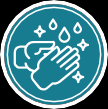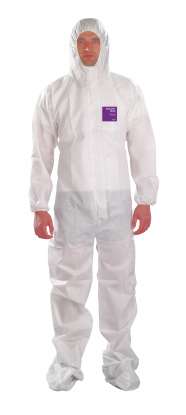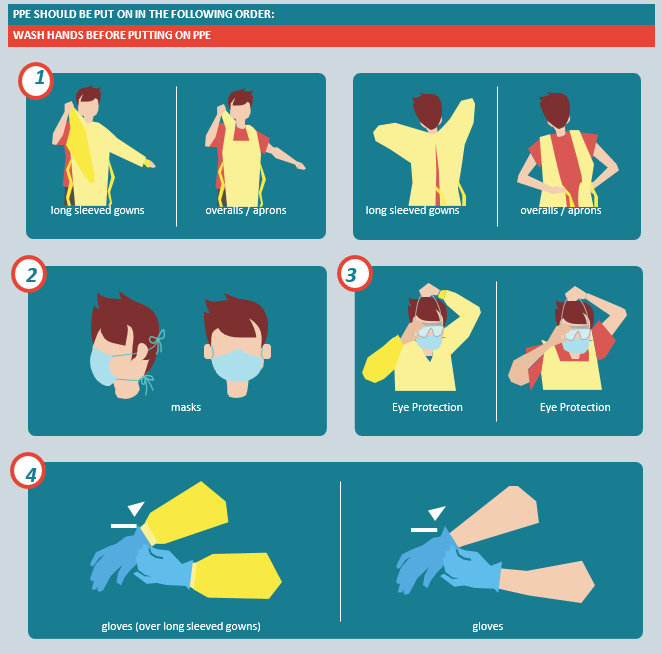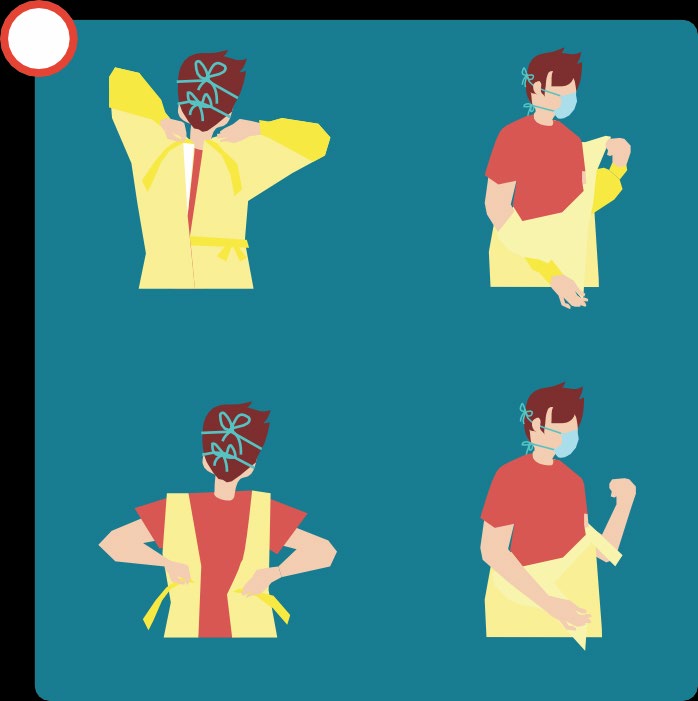 Complete PPE Guide – Custody/Prison All
Alert Levels
Complete PPE Guide – Custody/Prison All
Alert Levels As of 12 October 2021
GUIDELINES FOR STAFF ENTERING A PRISON SITE
1. The gate house area must be kept as clean as possible with regular disinfecting of high touch surfaces such as door handles.
2. The Ministry of Health COVID-19 health screening questions must be asked, they are:
Do you have any of the fol owing symptoms which may indicate an acute respiratory infection, or otherwise feel unwel ?
• New or worsening cough
• Sore throat
• Temporary loss of smel
• Fever greater than 38
• Sneezing or runny nose
• Shortness of breath
• Altered sense of taste
Have you:
a) been to a location of interest in the last 14 days?
b) have youy or anyone in their household been told to isolate at home; or is any household member currently waiting for COVID-19
test results?
c) worked on an international aircraft or shipping vessel?
d) worked in cold storage areas of facilities that receive imported chilled and frozen goods directly from an international airport or
maritime port?
e) exited an MIQ facility?
If anyone entering the prison has any of these symptoms, they should be refused entry, and ring Healthline for advice.
If a staff member or visitor has any of these symptoms, or generate an alert through a thermal detectio
1982
n device, which alert staff if
someone attempts to enter the prison with a temperature of (or above) 38 degrees, they must speak with a manager, return home
and ring Healthline. See the NUCTECH Thermal Camera Guidance for further information. Act
3. Hand sanitiser must be used before entering the site.
4. This guide includes instructions on how-to put-on PPE, below.
5. A screening process for prisoner receptions is to be completed (see Reception separation decision processes for at
AL1, and
AL2-4. 6. Staff, visitors, and prisoners will be required to wear PPE as set out in the table below. Co
Information ntractors must also wear PPE as per the PPE
guidelines and must be provided with PPE appropriate to the area/activity.
7. In the event of a Hospital Escort, staff will be guided by local DHB hospital directions for PPE use, but guidance is included
throughout this document for PPE requirements if escorts are COVID-19 related.
Official
8. Hand hygiene and cough / sneeze etiquette (maintain distance, cover coughs and sneezes with disposable tissues and wash
the
hands) will continue to have a big impact.
9. PPE Stock must be used as required; staff safety is paramount. A site register must be kept of al stock issued.
10. PPE stock takes for each site and Regional Hub m
under ust be completed and emailed by 12pm on the due date to
[email address]. Where different alert levels apply, the stock-take frequency for ALL REGIONS
wil be at the highest level for any ONE Region – e.g. where Auckland is at AL4 and the rest of NZ is at AL2, the frequency for
ALL REGIONS wil be Tuesday and Friday, being the AL4 frequency. This is to ensure that we have an accurate stock-take for all
PPE across all sites and can load-balance appropriately.
Released
• At Alert level 1 – fortnightly
• At Alert Level 2 – weekly
• At Alert Level 3-4 – every Tuesday and Friday by midday
11. When the NCC is operational / active - PPE stock takes are to be emailed to
CM
[email address].
12. Additional stocks of PPE (including hand sanitizer) will be ordered through National Office as required. These will be
distributed through the Regional Hubs. If your site has PPE-related requests that your Regional Hub cannot address, please
contact [email address]
13. Alcohol based sanitiser must not be accessible by prisoners. A small amount can be applied to their hands for them to use,
observed by staff, but they must not have free access to alcohol based sanitiser. All alcohol based sanitised in prisons must
be well controlled and stored appropriately.
pg. 1
 FACE MASKS AND FACE COVERINGS
FACE MASKS AND FACE COVERINGS
Approved face masks must be used within prisons, and not face coverings. This is because face coverings may assist with preventing
someone who has COVID-19 from ‘giving’ it to another person, but face masks provide better protection for preventing both the
‘giving’ and ‘receiving’ of COVID-19. To ensure everyone in prisons is protected from both spreading and catching the virus N95
masks – also known as a respirator - are to be used as per the table below. Staff will need to perform a fit check before wearing an
N95 mask,
every time. Replace the mask every 4 hours or if it becomes damp, damaged, soiled.
Posters are available for download from Tātou.
N95 MASKS also known as P2’s or Particulate respirator masks.
Since a more transmissible strain of COVID-19 entered NZ, N95 masks, ‘particulate respirators’, must also be worn by staff when
managing prisoners who are medium and high risk of COVID-19 (yellow, amber, red pathways) as in the ‘Reception, triage and
assessment process’ documents for the current Alert level status.
N95 masks have steel staples and aluminum nose clips. They must be stored securely, and access always limited to staff only.
Make sure they cannot be retrieved from the biohazard disposal containers by prisoners.
Before you put on your mask: 1. Inspect it for damage and throw it away if it is damaged.
2. With reverse side up and using the tab, separate top and bottom panels to form a cup shape. Bend it slightly at the centre
1982
of the nose clip.
Act
3. Ensure both panels are fully unfolded
4. Locate the upper strap across the crown of the head and the lower strap below the ears. Straps must not be twisted.
Adjust top and bottom panels for comfortable fit, ensuring panels and chin tab are not folded in.
5. Using both hands, mold nose clip to the shape of the lower part of the nose to ensure a close fit and good seal.
Information
6. Pinching the nose clip using only one hand may result in less effective respirator performance - use two hands.
7. Mold the respirator to your face by pressing, with your fingers, across the bridge of the nose and around your cheeks
until it fits snugly.
Official
8. The seal of the respirator on the face must be fit checked by the wearer before entering the area, or activity, where it is required.
the
To fit check the mask, the wearer will need to:
• Check the
positive pressure seal of the respirator by blowing out your breath (exhaling). If the seal is good, the respirator
under
should bulge slightly when you exhale. If air escapes between your face and the respirator, you do NOT have a good
facial seal. Re-adjust the respirator and repeat the fit check process.
• Check the
negative pressure seal of the respirator by breathing in, (inhaling). The respirator should collapse slightly when
you inhale. If the respirator is not drawn in
Released towards the face or air leaks, you do NOT have a good facial seal. Re-adjust the
respirator and repeat the fit check process.
If you are unable to achieve a good facial seal do not proceed with the activity or enter the area where it is required. Possible reasons for a poor fit may include:
• facial hair including 1-2 days beard growth which can interfere with an adequate seal. Any barrier to wearing a mask or issues
with shaving to achieve an adequate seal should be discussed with your manager. Managers should discuss these exceptions
on a case by case basis, with the support of Human Resources as appropriate.
• headbands or radio headpiece
To prevent failure of the N95 mask, once it is in the correct place, do not touch the front of the
mask or re-adjust it.
pg. 2

The N95 instructions:
Visual instructions released by the Ministry of Health and provid ed by 3M are provided below. These instructions include the
application, fit check (seal check) and removal of the N95 mask.
1982
Act
Information
Official
the
under
Released
ALTERNATIVE MASKS
Some staff members may confirm a medical reason with a medical certificate for being unable to use the standard issue face masks or the
N95 mask. Because the new masks provided meet the revised Ministry of Health standards for protection against COVID-19, no suitable
alternative masks are available for use in prisons. If you have a medical certificate for this reason, it should be discussed with your manager.
Managers should discuss these exceptions case by case, with the support of Human Resources as appropriate.
pg. 3




GENERAL INFORMATION
• As a means of reducing COVID-19 transmission between staff and prisoners and vice versa, Corrections staff must wear PPE appropriate to
the location they are working in, the activities they are undertaking and the movement of prisoners between areas of the prison.
• The wearing and changing of the correct PPE when working across COVID-19 Clean or COVID-19 Dirty areas must be adhered to.
• If escorting a prisoner who is at medium or high risk, PPE as per the guidelines is required.
• It’s important that we understand the best way that we can use and change these and how we can prevent or minimise some of the issues
that can arise from constant use of PPE.
• Where PPE is requested, but not required, people should be reminded that it can provide a false sense of security and hand hygiene, and
not touching your face, is effective protection against COVID- 19 transmission in most circumstances
• Regional leadership teams, including the Regional Operations Director Health, should continue to make risk-based decisions about
increasing the use of PPE for staff, where they believe it may be required.
• Where there is a change in the COVID-19 situation in the community, but no corresponding change in alert level, decisions can be made to
increase the use of PPE to a higher alert level. Where there are unique operational environments that present additional risk (e.g. HDU),
decisions on PPE use should be considered jointly with health and prison/regional leadership teams. Where increased use of PPE is
occurring, COVID leads should advise logistics (procurement) to ensure enough stock is available.
To ensure people with no known symptoms of COVID-19 are protected it is best practice to perform routine tasks by the fol owing groupings: 1. No known symptoms of covid-19 (cleanest). 2. Probable / suspected cases next. 3. Always do infected people last (infected)
GLOVES
1982
Wearing gloves continuously is more likely to spread infection as the surface of the gloves will be clea
Act ned less often. Constant glove wearing
causes hands to sweat causing skin irritation or damage. Good hand hygiene is as protective as glove wearing.
Gloves do not need to be worn for the prevention of transmission of COVID-19 but must still be worn at all other times as would normally be
required for activities within the prison (e.g. delivering health care / searching). Instead, hand hygiene with frequent hand washing and/or use
of hand sanitiser should be completed.
Staff should ensure hands are washed or sanitised between activities and regularly throughout the day.
Information
Wear disposable gloves only if you are likely to encounter substances, blood and body fluids or undertaking a task in which wearing disposable
gloves is part of the procedure.
On occasions, people can be sensitive to materials and substances used in glove manufacture. The most common one being latex sensitivity. If
Official
you suspect or know you are sensitive (or allergic) to latex, ensure you use the nitrile gloves available.
If your task means wearing gloves continuously, look to wash and dr
the y your hands when you change gloves and apply barrier cream every 2
hours if you can.
When disposable gloves are no longer needed for the task you are doing, remove them and wash your hands.
under
Gloves will generally need to be changed under the following circumstances:
• When the task is completed.
• When damaged or soiled,
• Before going to rest breaks and using the bathroom.
Released
• At a period of every 2 hours, or if hands become excessively sweaty inside the glove.
When removing gloves - ensure you use the correct technique and peel back from the inside placing one glove inside the other and putting
straight into the bin.
Wash (or sanitise) your hands
BEFORE you put on another pair of gloves.
HAND HYGIENE
It is important that we ensure our hand hygiene is as good as it can be - this wil help reduce the risk of spreading any virus and germs.
• Hand washing is the MOST effective way of removing any risk of virus getting into our system from hand contact.
• Warm water & soap -
20 seconds is needed (Sing happy birthday twice). • Dry hands, especial y between fingers and round wrists.
• Use barrier cream/hand cream when you can, especial y if hands feel dry.
• Perform hand hygiene prior before and on finishing any task, and throughout the day.
If you notice
ANY rash or itchiness on your hands - report into the H&S Tracker system so further advice can be provided.
pg. 4



ccc
TURTLESKIN GLOVES (OR SIMILAR)
• It is recommended hand sanitiser is used on search gloves in between searches of prisoners / cells / facilities to minimise spread
of infection.
• For Turtleskin gloves please follow the manufacturer guidelines - daily hand washing of search gloves with mild soap in warm
water and lay flat to air dry is best.
USING HAND SANITISER
This is generally used when water and soap are NOT available.
Some hand sanitisers can be irritating to the skin - if you know you have sensitive skin then DON’T use it! If you do use hand sanitiser,
follow these tips:
1. One pump of sanitiser is sufficient to clean the hands.
2. More is not always better.
3. Ensure the sanitiser has absorbed into your skin BEFORE you put on gloves (damp hands inside the gloves will increase the risk of
skin problems)
4. Alcohol based sanitiser must not be accessible by prisoners. A small amount can be applied to their hands for them to use,
observed by staff, but they must not have free access to alcohol based sanitiser. Al alcohol based sanitiser in prisons must be
wel controlled and stored/locked appropriately.
1982
SKIN PROBLEMS
Act
By following the guidance provided and assuming you have no known allergies to substances, latex etc - skin problems should not
normally occur.
If you notice any rashes, increased itching, swelling of your fingers or hands which are NOT normal for you - then report this
immediately and wait for advice on how best to proceed. See the guidance at the end of this document on alternative facemasks.
Information
EYE PROTECTION
Official
As we know that the coronavirus is absorbed through our mucus membranes (e.g. mouth, nose, skin and eyes) it is important that if
we are in contact with people with suspected or confirmed COVID-19), then we need to protect ourselves further.
the
Eye protection must be worn as per the table on the next page:
When the task you are doing requires you to wear eye protection (e.g. goggles or visor) apply the fol owing tips and rules. Discretion
can be used to determine whether goggles or a visor is most appropriate for the task.
under
1. If you wear glasses make sure the goggles are the ones designed to fit over spectacles
2. Unless eye protection becomes damaged or soiled (i.e. splashed with another person’s secretions) they DONOT need to be
thrown away or changed
3. Eye protection is designed to be wiped down and need to be stored in a clean, dry place when not in use (i.e. your locker)
4. Clean your eye protection at the start of the shift using warm soapy water and dry thoroughly using paper towels.
Released
5. Remove gloves BEFORE you remove your eye protection to prevent anything on the gloves going into your eyes.
6. Wash hands after removing ALL PPE and before putting on new PPE or your own personal clothing.
If for some reason the eye protection being offered to you is causing your own glasses to fog up or affect your ability to see clearly
then REPORT into the H&S Tracker system so further advice can be provided.
COVERALLS:
Coveralls
Coveralls are not part of PPE requirements recommended by the Ministry of Health. An example
of the coveralls is to the right. These should not be purchased. As per the PPE guide below, only
GOWNS should be worn by staff where they are required.
Coveralls are less convenient and more challenging than gowns and are potential hazards
especial y when taking them off. They require specific training and designated places for putting
on and taking off.
https://www.cdc.gov/coronavirus/2019-ncov/hcp/ppe-strategy/isolation-
gowns.html
pg. 5
5/10
HAND HYGIENE AND COUGHING AND SNEEZING ETIQUETTE CONTINUE TO BE CRITICAL TO STOP THE SPREAD OF COVID-19 AND APPLY TO EVERYONE, ALL THE TIME.
The BWC and ICP are both critical H&S controls and must be accessible for use when needed, including in spontaneous events. See page 8 for information on the use of gowns/aprons and BWC/ICP.
Setting
Role
Scenario
AL1
AL2
AL3
AL4
Working in a prison (in any position or capacity – including in offices
without prisoner contact).
No PPE
Masks | Hand Hygiene
Masks | Hand Hygiene | Gloves as appropriate for task
Masks | Hand Hygiene or Gloves
Working in a prison (anywhere) with prisoner contact (unless specified
No PPE
as appropriate for task
Masks | Hand Hygiene or Gloves as appropriate for task
below).
Masks | Hand Hygiene or Gloves
N95 Masks | Masks | Hand Hygiene or Gloves as appropriate for task
Working in a prison (anywhere) with visitor contact.
(No private visits, but statutory and specified may occur in limited circumstances)
No PPE
as appropriate for task
Masks | Hand Hygiene or Gloves
Staff (Al ) –
Working in a Mothers and Babies Unit
as appropriate for task
No PPE
N95 Masks | Gloves
including
contractors
Working in role of Internal Movements (not entering the Receiving Office,
No PPE
Masks | Hand Hygiene or Gloves as appropriate for task
Separation or Quarantine Units)
1982
Internal Movements from/to Receiving Office from/to Separation and
Masks | Gloves |Apron |Eye Protection
N95 Masks | Hand Hygiene or Gloves as appropriate for task | Gown | Eye Protection
Prisons
Quarantine Units
Act
Entering or working in the Receiving Office
Masks | Gloves |Apron | Eye Protection
N95 Masks | Hand Hygiene or Gloves as appropriate for task | Gown | Eye Protection
Separation units do not operate. Those who
N95 Masks | Gown | Eye Protection | Hand Hygiene or Gloves as appropriate for
Entering or working in a separation unit
started in AL2 complete 14 days (L2 PPE applies)
Masks | Apron
| Eye Protection | Hand Hygiene
task
or Gloves as appropriate for task
Information
N95 Masks | Gloves| Gown | Eye Protection
Entering or working in quarantine areas.
Separation units do not operate once those who
Prisoners
Accommodation and out of their cel in separation unit following
started in AL2 complete 14 days (L2 PPE applies)
Masks | Hand Hygiene encouraged
arrival to prison.
Official
(N95 masks are Being processed through the receiving office.
No PPE
Masks | Hand Hygiene encouraged
not to be
the
provided to
In quarantine and Interacting with staff or out of cell.
Masks | Hand Hygiene encouraged
prisoners to
use).
At all other times (when out of cell)
PPE is not required but can be provided if requested.
Masks
under
Under medical escorts
No PPE
Masks | Hand Hygiene.
Masks | Hand Hygiene.
Masks | Glove s as appropriate
Attending Court
No PPE
/Hand Hygiene.
Mask | Gloves| Gown |
Attending visits and in NZPB hearings where a support person is also in the
Masks | Glove
s as appropriate
Released
same room
No PPE
/Hand Hygiene.
NA – activity does not occur.
Al types of visitation (does not apply to children under 5 years old – no PPE
Visitors (All
Masks not required but can be provided if
Masks | Hand Hygiene.
Private visits do not occur, al
Private visits do not occur, al other visitors must
for under 5’s).
types)
requested
other visitors must wear:
wear:
(N95
• Visitors must not bring food to prisoners
masks are not to be
Masks | Gloves as appropriate
Masks | Gloves as appropriate or Hand Hygiene
provided to visitors • Physical contact between prisoners and visitors is discouraged.
or Hand Hygiene
to use).
Escort Staff
Al escorts to Court - including by First Security.
No PPE
Masks | Gloves as appropriate
/Hand Hygiene.
If suspected or confirmed case of COVID-19
N95 Masks | Gloves | Eye Protection |Gowns
N95 Masks | Gloves | Eye Protection |Gowns
If suspected or confirmed case of Goggles and gloves can be removed while driving, but both must be re applied on
COVID-19
N95 Masks | Gloves |
exiting the vehicle.
Al other escorts (including to medical/health facilities).
Eye Protection |Gowns
pg. 6
 Complete PPE Guide – Custody/Prison All
Alert Levels
Complete PPE Guide – Custody/Prison All
Alert Levels As of 12 October 2021
KEY REQUIREMENTS FOR PPE USE:
• Gloves and masks are to be used if you are cleaning/sanitising something that has been used by someone else.
• More frequent cleaning / sanitising of surface areas are required in these situations.
• Hand hygiene is also vitally important where gloves are an existing requirement (unrelated to COVID-19) and
mandatory for the task/activity being completed (e.g. searching/health provision).
• Mask use for prisoners out of cell is not mandatory but should be encouraged. Mask use should not be applied as a
lawful order and if a prisoner refuses to wear a mask no enforcement or other action is expected to occur (the risk
presented by a smal number of prisoners refusing to wear a mask is not sufficient to warrant a lawful or tactical
engagement with the prisoner for compliance); unless the prisoner is in quarantine or a separation unit or receiving
a COVID-19 vaccination. Masks are mandatory for prisoners in these circumstances.
o If the prisoner refuses to wear a mask during a vaccination, they cannot receive the vaccine.
1982
o If the prisoner refuses to wear a mask in quarantine or separation, their minimum entitlement to exercise
Act
and/or phone cal s can be denied due to the risk to the safety and welfare of other prisoners and staff
• As a means of reducing COVID-19 transmission between staff and prisoners and vice versa, Corrections staff must
wear PPE appropriate to the location they are working in, the activities they are undertaking and the movement
Information
prisoners between areas of the prison.
• The wearing and changing of the correct PPE when working across COVID-19 Clean or COVID-19 Dirty areas must be
adhered to.
Official
• In alert levels 1-2 Separation areas are not COVID-19
the dirty areas.
• In alert levels 3-4 Separation areas are COVID-19 dirty areas.
under
• Receiving Offices and Quarantine units are COVID-19 dirty areas at all alert levels.
• Other areas are considered COVID-19 Clean, unless used by a prisoner from a COVID-19 dirty area. In which case it
will require cleaning after use (e.g. AVL suite).
Released
• Each prison must consider how their site is configured, and how movements occur between COVID-19 clean, and
COVID-19 dirty area (e.g. RO to Quarantine and RO to Separation) and ensure there are appropriate provisions for
changing PPE when moving between COVID-19 dirty areas, and other areas.
• If escorting a prisoner who is at medium or high risk, PPE as per the guidelines is required.
pg. 7

 Complete PPE Guide – Custody/Prison All
Alert Levels
Complete PPE Guide – Custody/Prison All
Alert Levels As of 12 October 2021
CHANGING FROM A N95 MASK TO A STANDARD MASK:
When staff are moving from an area or activity here n N95 mask is required, to an area or activity where an N95 mask is NOT
required, the N95 mask must be removed and disposed of in a biohazard bin/container.
1982
Act
Information
Official
the
under
Released
REMEMBER - STEPS TO PUT ON PPE:
3. Eye protection
1. Long sleeved fluid resistant, disposable aprons / long sleeved
4. Gloves
gowns (where required)
2. Mask / N95 mask
SAFE ADAPTION OF DISPOSABLE GOWNS TO ACCESS BWC AND ICP
• On a clean surface collect scissors, wipes to clean BWC and ICP
• On the hip, snip the gown to allow access to the ICP.
• Wash hands
• Keep the snip small but practical.
• Using the wipes clean the scissors, BWC and ICP
• Wash hands
• Dispose of wipes in bin
Continue to put on remaining PPE in the order below
• Wash hands
Mask or N95 mask
• Put on gown
Eye protection
With clean scissors snip the gown and pull the BWC through the
Gloves
hole to be visible. Keep the snip as small as possible.
pg. 8





 Complete PPE Guide – Custody/Prison All
Alert Levels
Complete PPE Guide – Custody/Prison All
Alert Levels As of 12 October 2021
PPE SHOULD BE TAKEN OFF IN THE FOLLOWING ORDER:
WASH HANDS AFTER TAKING OFF PPE AND BETWEEN EACH STEP
REMEMBER - STEPS TO TAKE OFF PPE:
1. Gloves (if wearing, if not, perform hand hygiene)
2. Long sleeved fluid resistant, disposable aprons / long sleeved gowns (where required)
3. Eye protection
4. Mask / N95 mask
1
2
1982
Act
gloves (over long sleeved gowns)
long sleeved gowns
Information
Official
gloves
overalls / aprons
the
Remove gloves, being careful to avoid touching the
Remove the gowns, being careful to avoid contaminating
under
outside of the gloves:
clothing:
• Outside of gloves are contaminated.
• Assume gown front and sleeves are contaminated.
• If your hands get contaminated during glove
• If your hands get contaminated during gown
removal, immediately wash your hands or use an
removal, immediately wash your hands, or use
alcohol-based hand sanitiser.
Released
an alcohol-based hand sanitiser.
• Using a gloved hand, grasp the palm area of the
• Unfasten gown ties, taking care that sleeves don’t
other gloved hand and peel off first glove.
contact your body when reaching for ties.
• Hold removed glove in gloved hand.
• Pul gown away from neck and shoulders, touching
• Slide fingers of ungloved hand under remaining
inside of gown only.
glove at wrist and peel off the second glove over the
• Turn gown inside out. Fold/roll into a bundle and
first glove.
discard in a waste container.
• Discard gloves in a waste container
• No change in clothing worn under PPE is required
• Wash hands with soap and water.
unless that clothing has become contaminated.
• Wash hands with soap and water.
Removing adapted gown
• Dispose of wipes
• Collect cleaning wipes
• Wash hands
• Remove gloves
• Dispose of gown
• Dispose of gloves
Remove remaining PPE in order below
• Wash hands
- Eye protection
• Remove adapted gown careful y over the ICP and BWC
- Mask/N95
• Dispose of gown
- Wash hands
• Using the wipes clean BWC and ICP
pg.9












 Complete PPE Guide – Custody/Prison All
Alert Levels
Complete PPE Guide – Custody/Prison All
Alert Levels As of 12 October 2021
PPE SHOULD BE TAKEN OFF IN THE FOLLOWING ORDER:
WASH HANDS AFTER TAKING OFF PPE AND BETWEEN EACH STEP
3
4
How to remove a mask:
Remove the mask, being careful not to touch the front of
• Wash hands with soap and water or use hand
the mask:
sanitiser
• Front of mask/respirator is con
1982 taminated.
• Avoid touching the front of the mask
• If your hands get contaminated during mask
• If the mask has ties, untie the bottom, then top tie
removal, immediately wa
Act sh your hands or use an
• Remove from face
alcohol-based hand sanitiser.
• Discard, do not use again
• Grasp bottom ties or elastics of the mask, then the
• Wash hands with soap and water.
ones at the top, and remove without touching the
front.
• Discard in a waste container.
• Wash hands to el
Information
bows or use an alcohol-based hand
sanitiser Immediately after removing all PPE.
CHANGE GLOVES OR GOWN/OVERALLS AS SOON AS POSSIBLE IF THEY BECOME TORN OR SOILED, PERFORMING HAND HYGIENE
Official
AFTER REMOVING EACH PIECE OF PPE
the
The Body Worn Cameras (BWC) and Individual Carry Pepper Spray (ICP) are both critical H&S controls and must be accessible for
use when needed, including in spontaneous events.
Factors considered include:
under
- Gowns are required to be worn in areas where we know the risk of violence and aggression from prisoners is present, and
in some areas, higher.
- Gowns protect the upper body only from bodily fluids that may be expel ed from people in these areas, meaning the
trousers and boots are not protected.
- The BWC and ICP are not large and the
Released surfaces are not permeable and can be easily surface cleaned.
Given this and on balance of risk, when both gowns, in these areas can be carefully adapted to accommodate the ICP and BWC
external y to the gown by cutting the gown to allow for access to ICP and BWC.
Safe adaption of disposable gowns to access BWC and ICP
• On a clean surface collect scissors, wipes to clean BWC and ICP
to be visible. Keep the snip as small as possible.
• Wash hands
• On the hip, snip the gown to allow access to the ICP.
• Using the wipes clean the scissors, BWC and ICP
• Keep the snip small but practical.
• Dispose of wipes in bin
• Wash hands
• Wash hands
• Continue to put on remaining PPE in the order below
• Put on gown
- Mask or N95 mask
• With clean scissors snip the gown and pull the BWC through the
- Eye protection
hole
- Gloves
Removing adapted gown
• Dispose of wipes
• Collect cleaning wipes
• Wash hands
• Remove gloves
• Dispose of gown
• Dispose of gloves
• Remove remaining PPE in order below
• Wash hands
- Eye protection
• Remove adapted gown careful y over the ICP and BWC
- Mask/N95
• Dispose of gown
- Wash hands
pg.10








 Complete PPE Guide – Custody/Prison All
Alert Levels
Complete PPE Guide – Custody/Prison All
Alert Levels As of 12 October 2021
DISPOSING OF PPE:
•
All PPE worn in the prison (by staff and prisoners) needs to be disposed of in the biohazard bin.
• Biohazard (yellow) bins should be placed in the gatehouse and any other location where PPE is used and then
discarded (pods etc.)
• All bio bins must have a bag liner.
• All used PPE is to be places in the bio bins when removed.
• Yellow bags used as bin liners in units are to be removed when ful , and the ful bag placed in the bio bins
• When ful , the bio bins are to be put out for col ection by Waste Management. If a site has been provided with a
bio-waste skip, then the bags from the bio-waste wheelie bins can be removed and placed into these skips. These
must not be emptied into general waste (landfil ) skips.
• Ful PPE (gown, mask, gloves, eye protection) must be worn when bags are removed from the bio-waste wheelie
bins and placed into a bio-waste skip that has been provided by Waste Management
• At all times, waste management guidelines must be adhered to.
• PPE worn by prisoners must be placed in the bags provided in the units and not handled/passed to staff.
PPE is used by staff member
Once us
1982 ed, place it straight
(anywhere in the prison)
into a biohazard bin (these bins
Act are lined, and PPE does not
See the PPE guidelines for
need to be double-bagged.
information on when PPE should
There is one bin in every unit.
be changed.
Information
Official
the
under
PPE waste will be col ected weekly.
Note: If PPE waste needs to be disposed of more frequently,
this is to be managed at a site level.
Released
pg. 11
Document Outline








































